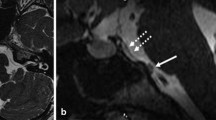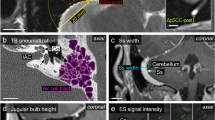Abstract
Objectives
To propose a new classification for ecchordosis physaliphora (EP) using fast imaging employing steady-state acquisition (FIESTA).
Methods
We evaluated 974 consecutive patients and selected for further study 78 (8.0 %) who manifested an excrescence on the dorsal surface of the clivus (DSC) and/or clivus lesions. Lesions were defined as “classical EP” when they appeared as a hyperintense excrescence (cyst-like component) on DSC. Other lesions were defined as “possible EP”.
Results
Of the 78 patients, 17 (22 %) were diagnosed with classical EP, the other 61 with possible EP. The 61 patients with possible EP were further classified into “incomplete EP = EP bud” (n = 55, 90.2 %), characterised by a T2 hypointense protrusion of the clivus, and into “EP variant” (n = 6, 9.8 %), characterised by hyperintense lesions within only clivus. FIESTA findings of incomplete EP were similar to those of classical EP except for lack of the hyperintense excrescence on DSC. Most lesions were located at the level of the Dorello canal at the midline of the craniospinal axis.
Conclusion
Our results suggest that the magnetic resonance imaging appearance of EP is diverse. Based on our FIESTA results we propose a new classification for EP, i.e. classical EP, incomplete EP (EP bud) and EP variant.
Key Points
• Ecchordosis physaliphora (EP) is a rare benign cystic congenital lesion arising from notochord.
• The classical type of EP is frequently associated with a T2 hypointense protrusion.
• T2 hypointense protrusions without clivus cysts may represent an incomplete type of EP.
• Third type of EP variant only harbours lesions within the clivus.




Similar content being viewed by others
Abbreviations
- DSC:
-
Dorsal surface of the clivus
- EP:
-
Ecchordosis physaliphora
- FIESTA:
-
Fast imaging employing steady-state acquisition
References
Wolfe JT III, Scheithauer BW (1987) “Intradural chordoma” or “giant ecchordosis physaliphora”? report of two cases. Clin Neuropathol 6:98–103
Rodriguez L, Colina J, Lopez J, Molina O, Cardozo J (1999) Intradural prepontine growth: giant ecchordosis physaliphora or extraosseous chordoma? Neuropathology 19:336–340
Toda H, Kondo A, Iwaski K (1998) Neuroradiological characteristics of ecchordosis physaliphora: Case report and review of the literature. J Neurosurg 89:830–834
Cha ST, Jarrahy R, Yong WH, Eby T, Shahinian HK (2002) A rare symptomatic presentation of ecchordosis physaliphora and unique endoscope-assisted surgical management. Minim Invas Neurosurg 45:36–40
Mehnert F, Beschorner R, Kuker W, Hahn U, Nagele T (2004) Retroclival ecchordosis physaliphora: MR imaging and review of the literature. AJNR Am J Neuroradiol 25:1851–1855
Haacke EM, Wielopolski PA, Tkach JA, Modic MT (1990) Steady-state free precession imaging in the presence of motion: application for improved visualization of the cerebrospinal fluid. Radiology 175:545–552
Tsuchiya K, Aoki C, Hachiya J (2004) Evaluation of MR cisternography of the cerebellopontine angle using a balanced fast-field-echo sequence: preliminary findings. Eur Radiol 14:239–242
Chung HW, Chen CY, Zimmerman RA, Lee KW, Lee CC, Chin SC (2000) T2-weighted fast MR imaging with true FISP versus HASTE: comparative efficacy in the evaluation of normal fetal brain maturation. AJR Am J Roentgenol 175:1375–1380
Yamamoto J, Kakeda S, Takahashi M (2011) Dural attachment of intracranial meningiomas: evaluation with contrast-enhanced three-dimensional fast imaging with steady-state acquisition (FIESTA) at 3 T. Neuroradiology 53:413–423
Ho KL (1985) Ecchordosis physaliphora and chordoma: a comparative ultrastructural study. Clin Neuropathol 4:77–86
Akimoto J, Takeda H, Hashimoto T, Haraoka J, Ito H (1996) A surgical case of ecchordosis physaliphora [in Japanese]. No Shinkei Geka 24:1021–1025
Sassin JF (1975) Intracranial chordoma. In: Vinkin PJ, Bruyn GW (eds) Handbook of clinical neurology, vol 18, Tumours of the brain and skull, part III. Elsevier, New York, pp 151–164
Srinivasan A, Goyal M, Kingstone M (2008) Ecchordosis physaliphora. Radiology 247:585–588
Macdonald RL, Cusimano MD, Deck JH, Gullane PJ, Dolan EJ (1990) Cerebrospinal fluid fistula secondary to ecchordosis physaliphora. Neurosurgery 26:515–519
Stam FC, Kamphorst W (1982) Ecchordosis physaliphora as a cause of fatal pontine hemorrhage. Eur Neurol 21:90–93
Katayama Y, Tsubokawa T, Hirasawa T, Takahata T, Nemoto N (1991) Intradural extraosseous chordoma in the foramen magnum region: Case report. J Neurosurg 75:976–979
Mapstone TB, Kaufman B, Ratcheson RA (1983) Intradural chordoma without bone involvement: nuclear magnetic resonance (NMR) appearance. Case report. J Neurosurg 59:535–537
Fracasso T, Brinkmann B, Paulus W (2008) Sudden death due to subarachnoid bleeding from ecchordosis physaliphora. Int J Legal Med 122:225–227
Kurokawa H, Miura S, Goto T (1988) Ecchordosis physaliphora arising from the cervical vertebra, the CT and MRI appearance. Neuroradiology 30:81–83
Yamaguchi T, Suzuki S, Ishiiwa H (2004) Benign notochordal cell tumors: a comparative histological study of benign notochordal cell tumors, classic chordomas, and notochordal vestiges of fetal intervertebral discs. Am J Surg Pathol 28:756–761
Yamaguchi T, Suzuki S, Ishiiwa H, Ueda Y (2004) Intraosseous benign notochordal cell tumours: Overlooked precursors of classic chordomas? Histopathology 44:597–602
Nishiguchi T, Mochizuki K, Ohsawa M, Inoue T, Kageyama K, Suzuki A, Takami T, Miki Y (2011) Differentiating benign notochordal cell tumors from chordomas: Radiographic features on MRI, CT, and tomography. AJR Am J Roentgenol 196:644–650
Author information
Authors and Affiliations
Corresponding author
Rights and permissions
About this article
Cite this article
Chihara, C., Korogi, Y., Kakeda, S. et al. Ecchordosis physaliphora and its variants: proposed new classification based on high-resolution fast MR imaging employing steady-state acquisition. Eur Radiol 23, 2854–2860 (2013). https://doi.org/10.1007/s00330-013-2888-9
Received:
Revised:
Accepted:
Published:
Issue Date:
DOI: https://doi.org/10.1007/s00330-013-2888-9




